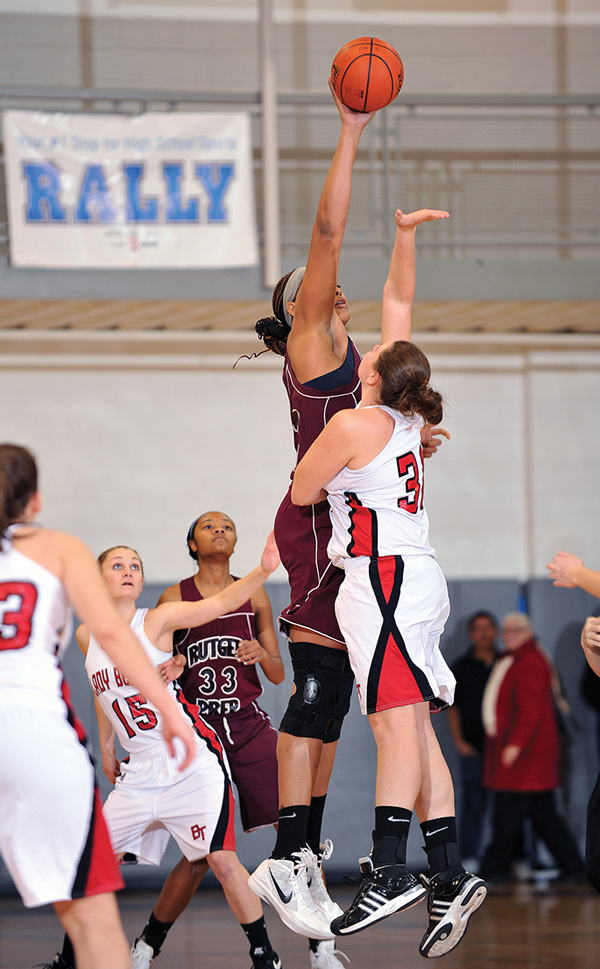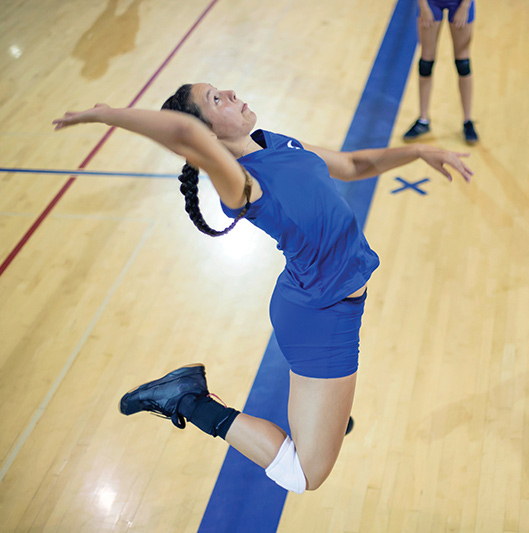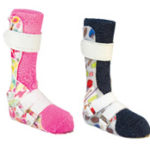 Pediatric patellofemoral pain hasn’t historically received much research attention. Recently some experts have said it can have a long-term negative impact. New research suggests some basic solutions to the common yet often overlooked problem that can cause kids to drop out of sports.
Pediatric patellofemoral pain hasn’t historically received much research attention. Recently some experts have said it can have a long-term negative impact. New research suggests some basic solutions to the common yet often overlooked problem that can cause kids to drop out of sports.
By Lori Roniger
Symptoms of patellofemoral pain (PFP) are similar among patients of all ages, but contributing factors differ between adults and kids, suggesting a need for different treatment and prevention strategies. Michael Rathleff, PT, PhD, senior researcher at the Research Unit for General Practice in Aalborg, Denmark, is the most prolific researcher in this area. He was motivated to study PFP in children and adolescents at the suggestion of a mentor, who was an orthopedic surgeon.
“He inspired me to look into this because he felt it was really underappreciated and under-researched,” Rathleff said, noting less than 5% the PFP literature has focused on adolescents. “I would like to inspire more people to do the same.” He also recalled that a physical education teacher contacted him about eight years ago about the prevalence of knee pain among kids, thinking it might be only in their heads or that they were making it up.
“Our research clearly demonstrated that was absolutely wrong,” Rathleff said.
In 2011, Rathleff and colleagues administered an online questionnaire to 2200 adolescents and found about one-fourth reported knee pain; of the total group, about 7% were diagnosed with PFP.1 More than half (56%) of those with knee pain at baseline continued to report it two years later; those diagnosed with PFP were more likely to still have it—and were more likely to have reduced or stopped sports participation—than those with other types of knee pain. The findings, published this year in the American Journal of Sports Medicine (AJSM),2 suggest knee pain and PFP in particular may not be self-limiting in this population.
“We think it is one of the most common knee conditions in adolescents and adults,” Rathleff said.
 Similarly, the results of a paper published in The Knee this year call into question the traditional belief that adolescent anterior knee pain is benign.3 The authors found adults with symptomatic patellofemoral osteoarthritis (OA) were 7.5 times more likely to report having had anterior knee pain as adolescents than those with tibiofemoral OA.
Similarly, the results of a paper published in The Knee this year call into question the traditional belief that adolescent anterior knee pain is benign.3 The authors found adults with symptomatic patellofemoral osteoarthritis (OA) were 7.5 times more likely to report having had anterior knee pain as adolescents than those with tibiofemoral OA.
“We’re working on looking at what structural risk factors in the knee can lead to patellofemoral pain,” said Damian Clark, MBBS, an orthopedic surgeon working on a clinical fellowship at Foothills Medical Centre in Calgary, Canada, and one of the study’s authors.
PFP is more than twice as prevalent in adolescent girls than boys in the same age group,4 similar to the ratio in adults, according to Rathleff’s research.
He has also found about 40% of adolescents with PFP don’t seek medical care for the condition.1 “A lot of the parents think that it’s a normal part of growing up,” Rathleff said.
Who gets it?
In Rathleff’s study, two-thirds of adolescents with PFP were highly active and played sports, on average, five times a week. However, the remaining third did not engage in any sports, challenging the notion that PFP is always a load-dependent condition associated with sports.5
The high prevalence among athletes “suggests that highly repetitive and/or excessive and specific loading contributes to the pathogenesis of PFP in adolescents,” he wrote recently in an editorial in the British Journal of Sports Medicine.5 This includes a 16% prevalence in female adolescent basketball players, reported in 2010 by researchers from Cincinnati Children’s Hospital Medical Center in Ohio.6
Greg Myer, PhD, associate professor of pediatrics and director of research for the Human Performance Laboratory at Cincinnati Children’s Hospital Medical Center, and his colleagues are working on creating a risk profile for young athletes who develop PFP.
“What we’re trying to do is move beyond just one predictive factor,” Myer said. “We think many things contribute to patellofemoral pain in the younger athlete.”
Much of his previous research has focused on the biomechanics of knee injuries, including anterior cruciate ligament (ACL) injury. “It’s a natural evolution to look at this,” he said.
Myer and his colleagues are following more than 700 female athletes, who play basketball, volleyball, and soccer in middle school and high school, to see if the PFP risk profiles of children change as they mature.
A study by Myer and colleagues published in the British Journal of Sports Medicine (BJSM) in 2015 found high knee abduction moments are a risk factor for developing both PFP and anterior cruciate ligament (ACL) injury in adolescent female athletes, suggesting young girls with PFP may be at risk for future ACL injury.7 In one cohort of girls with a mean age of 13.3 years, those with a knee abduction load greater than 15 Nm during landing were more likely to develop PFP than those below the threshold; in a separate cohort of girls with a mean age of 16.1 years, a cutoff of 25 Nm of knee abduction load during landing was associated with increased risk of both PFP and ACL injury.
Rathleff, however, said his data do not indicate that adolescents with PFP get ACL injuries. “The adolescents with longstanding PFP drop out of their sports,” he said.
Myer and colleagues have also found that athletes who specialize in one sport have a higher risk of anterior knee pain disorders, including PFP, than multisport athletes.8 This may be because focusing on a single sport doesn’t allow for the development of as diverse and broad a range of neuromuscular patterns, Myer said.
Christian Barton, PhD, BPhysio(Hons), an expert on PFP and a researcher at La Trobe University in Melbourne, Australia, said he sometimes sees adolescents in the clinic with PFP who are playing three different sports at the same time. They may be participating in as many as nine high-level sports sessions a week.
“As children and adolescents grow, their muscular strength development often lags behind their skeletal growth,” said Curtis VandenBerg, MD, an assistant professor and pediatric orthopedic surgeon with a focus on sports medicine at Children’s Hospital Los Angeles. “Since muscle weakness and imbalance can be an underlying risk factor for the development of patellofemoral pain syndrome, growth can increase a child’s or adolescent’s risk for developing this pain.”
Myer and his colleagues have also looked into the issue of hip strength in PFP. Although studies of adults have found PFP is associated with hip muscle weakness,9 their study of 329 adolescent female athletes published last year in the AJSM found greater hip abduction strength in those who developed PFP than those who didn’t. They theorized that the strength may be due to increased hip adduction on landing, and that PFP results when this compensatory balance fails.10
Isn’t all patellofemoral pain the same?
Rathleff’s research suggests that, while PFP may present in a similar way in adolescents and adults, it may not be due to the same underlying issues and may require different treatments.
Success rates for PFP treatments appear to differ between adolescents and adults, even with similar exercise treatments and compliance, he and colleagues wrote in an opinion article published in Sports Medicine last year.11 His research has also found adolescents with PFP had symptoms lasting more than three years,1,12,13 which is longer than found in adults. In studies of adults with PFP, long symptom duration has been associated with poorer outcomes after treatment.14,15
“It is tempting to speculate that one of the reasons for adolescent outcomes to be lower than adults is that adults have learned to avoid physical activity that aggravates their pain, whereas adolescents have not,” Rathleff and colleagues wrote in Sports Medicine.11
VandenBerg concurs that different mechanisms may be at work in pediatric and adult patients. “Children do not tend to have cartilage changes or chondromalacia in the patellofemoral joint, as adults commonly do,” he said.
Pain, pain go away
Experts’ views on the cause of PFP tend to guide how they think it’s best treated.
“We spend way too much time on exercise [in adolescents],” said Rathleff, who sees PFP as less about muscle strength and more about load versus capacity. “I think we should spend much more time on patient education.”
He recommends providing education to adolescent patients and their parents about self-management rather than simply focusing on exercises. A study Rathleff recently completed, which enrolled 150 children aged 10 to 14 years, was based on just this hypothesis. (Results are unpublished.)
Rathleff and Barton have created an educational booklet for patients with PFP and would like to produce one for adolescents, which Rathleff said would focus more on load progression and management and less on strength.
His group has found some benefit of exercise in adolescents with PFP. In a 2015 BJSM study, adolescents with PFP randomized to patient education and exercise therapy were more likely to have recovered at three months and even more so at two years (44%) than those who received patient education alone (22%).16
But, they’ve also found plenty of room for improvement when it comes to adherence to exercise treatments for PFP in adolescents. Lately, they have been using a sensor that allows them to capture data about time under tension, repetitions, and sets of elasticized-band exercises performed at home. The results of one study on adolescents with PFP indicate that only 15% of the total exercise dosage prescribed is being done.17
One way to address this might be to let adolescents choose which exercises they prefer from among a few, Rathleff said. But better education should also help, he said.
“I do think once you’ve got the whole education side of things in place and load management, then you would do hip and knee exercises, just as in adults. But we know that compliance might be a really big obstacle to creating adherence,” Rathleff said.
Barton is employing some educational strategies clinically, for example in kids who develop PFP after they’ve increased their activity levels, such as by adding a third sport. He will talk with the patient and parents, suggesting cutting back regular activity to maybe half or two-thirds. In some cases, they build back up from walking with minimal pain to being able to handle stairs and later jogging and returning to training and competition.
Taping to offload the joint and the use of temporary prefabricated foot orthoses can also be helpful in some cases, Barton said. Those as young as 10 years typically won’t need a lot of strength work, while a few hip exercises could be helpful, he said. Older adolescents may have strength deficits that require work, though it’s necessary to make sure exercise doesn’t exacerbate their knee pain.
The motion analysis laboratory at Children’s Hospital Los Angeles allows VandenBerg and his colleagues to assess patients with PFP and to tailor a physical therapy plan for them. Additionally, they have been gathering data on control patients they hope to use for comparison to better understand the factors that may contribute to PFP.
VandenBerg recommends a targeted strengthening and stretching program similar to those that have been studied in adults,18 working with a physical therapist if possible, or teaching patients a few exercises to do at home.
Training to prevent pain
To prevent PFP, Myer suggests gluteus maximus and hamstrings training to help develop strength and control. These can include deep knee flexion, Russian hamstring curl, glute-ham bridge, and single-leg Romanian deadlift. Exercises can be effective in kids as young as 5 years, if they are able to understand instructions and perform movements as prescribed, he said.
He also suggests strategies to keep things fun for kids. His research group will be examining the use of augmented reality and biofeedback for neuromuscular training.
Darin Padua, ATC, PhD, professor and chair of the Department of Exercise and Sport Science at the University of North Carolina at Chapel Hill, suggests breaking an exercise program into smaller parts, such as three five-minute chunks throughout a session. Internal cues also are helpful for kids, such as telling them to bend their knees, whereas the instruction to land softly can work better for adults. Foot orthoses, taping, and bracing can also be helpful in children and adolescents with PFP, he said.
Rathleff would like to provide some education for sports coaches, noting that musculoskeletal complaints start at around age 10 years. And, he would like to see physical education classes incorporate injury prevention programs that include games and work to improve coordination, balance, and strength, similar to the FIFA 11+ program.20
But, one reason for the relatively high prevalence of PFP in adolescents could be because so many schools have deprioritized physical education, Padua said.
“Now all of these fundamental motor development skills are no longer being taught,” he said.
Myer agreed.
“We should all be doing these types of exercises,” he said. “[Schools] keep cutting physical education, and we need to be adding more.”
Lori Roniger is a freelance writer based in San Francisco, CA.
- Rathleff MS, Skuldbol SK, Rasch MN, et al. Care-seeking behavior of adolescents with knee pain: A population based study among 504 adolescents. BMC Musculoskelet Disord 2013;14:225.
- Rathleff MS, Rathleff CR, Olesen JL, et al. Is knee pain during adolescence a self-limiting condition? Prognosis of patellofemoral pain and other types of knee pain. Am J Sports Med 2016;44(5):1165-1171.
- Conchie H, Clark D, Metcalfe A, et al. Adolescent knee pain and patellar dislocations are associated with patellofemoral osteoarthritis in adulthood: a case control study. Knee 2016 May 11. [Epub ahead of print]
- Rathleff CR, Roos EM, Olesen JL, et al. Prevalence and severity of patellofemoral pain among adolescents—a population-based study. Presented at the 3rd International Patellofemoral Pain Research Retreat, Vancouver BC, September 2013.
- Rathleff MS. Patellofemoral pain during adolescence: much more prevalent than appreciated. Br J Sports Med 2016;50(14):831-832.
- Myer GD, Ford KR, Barber Foss KD, et al. The incidence and potential pathomechanics of patellofemoral pain in female athletes. Clin Biomech 2010;25(7):700-707.
- Myer GD, Ford KR, Di Stasi SL, et al. High knee abduction moments are common risk factors for patellofemoral pain (PFP) and anterior cruciate ligament (ACL) injury in girls: Is PFP itself a predictor for subsequent ACL injury? Br J Sports Med 2015;49(2):118-122.
- Hall R, Barber Foss KD, Hewett TE, Myer GD. Sport specialization’s association with an increased risk of developing anterior knee pain in adolescent female athletes. J Sport Rehabil 2015;24(1):31-35.
- Rathleff MS, Rathleff CR, Crossley KM, Barton CJ. Is hip strength a risk factor for patellofemoral pain? A systematic review and meta-analysis. Br J Sports Med 2014;48(14):1088.
- Herbst KA, Barber Foss KD, Fader L, et al. Hip strength is greater in athletes who subsequently develop patellofemoral pain. Am J Sports Med 2015;43(11):2747-2752.
- Rathleff MS, Vicenzino B, Middelkoop M, et al. Patellofemoral pain in adolescence and adulthood: same same, but different? Sports Med 2015;45(11):1489-1495.
- Collins N, Crossley K, Beller E, et al. Foot orthoses and physiotherapy in the treatment of patellofemoral pain syndrome: randomised clinical trial. BMJ 2008;337:a1735.
- van Linschoten R, van Middelkoop M, Berger MY, et al. Supervised exercise therapy versus usual care for patellofemoral pain syndrome: an open label randomised controlled trial. BMJ 2009;339:b4074.
- Collins NJ, Crossley KM, Darnell R, Vicenzino B. Predictors of short and long term outcome in patellofemoral pain syndrome: a prospective longitudinal study. BMC Musculoskelet Disord 2010;11:11.
- Blond L, Hansen L. Patellofemoral pain syndrome in athletes: a 5.7-year retrospective follow-up study of 250 athletes. Acta Orthop Belg 1998;64(4):393-400.
- Rathleff MS, Roos EM, Olesen JL, Rasmussen S. Exercise during school hours when added to patient education improves outcome for 2 years in adolescent patellofemoral pain: a cluster randomised trial. Br J Sports Med 2015;49(6):406-412.
- Rathleff MS, Bandholm T, McGirr KA, et al. New exercise-integrated technology can monitor the dosage and quality of exercise performed against an elastic resistance band by adolescents with patellofemoral pain: an observational study. J Physiother 2016;62(3):159-163.
- Van der Heijden RA, Lankhorst NE, van Linschoten R, et al. Exercise for treating patellofemoral pain. Cochrane Database Syst Rev 2015;1:CD010387.
- Soligard T, Myklebust G, Steffen K, et al. Comprehensive warm-up programme to prevent injuries in young female footballers: cluster randomized controlled trial. BMJ 2008;337:a2469.




